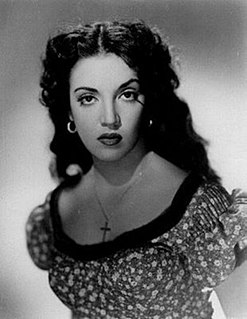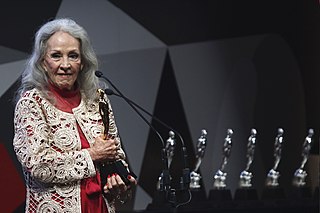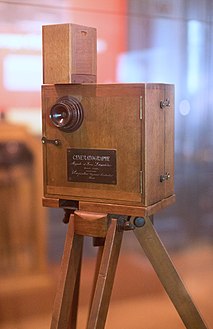
María Cristina Estela Marcela Jurado García, better known as Katy Jurado, was a Mexican film, stage, and television actress.

The Ariel is the Mexican Academy of Film Award. It has been awarded annually since 1947. The award recognizes excellence in motion picture making, such as acting, directing and screenwriting in Mexican cinema. It is considered the most prestigious award in the Mexican movie industry. In cinema, it is considered Mexico's equivalent to the Academy Awards ("Oscars") of the United States.

The Golden Age of Mexican cinema is a period in the history of the Cinema of Mexico between 1933 and 1964 when the Mexican film industry reached high levels of production, quality and economic success of its films, besides having gained recognition internationally. The Mexican film industry became the center of commercial films in Latin America.

The porfiriato or porfirismo was a period in the history of Mexico when central power was held by Porfirio Díaz, between November 28, 1876, and May 25, 1911.
Nuevo Cine Mexicano, also referred to as New Mexican Cinema is a Mexican film movement started in the early 1990s. Filmmakers, critics, and scholars consider Nuevo Cine Mexicano a "rebirth" of Mexican cinema because of the production of higher-quality films. This rebirth led to high international praise as well as box-office success, unseen since the golden age of Mexican cinema of the 1930s to 1960s. The quality of Mexican films suffered in the decades following the golden age due in part to Mexican audiences watching more overseas films, especially Hollywood productions. This resulted in the rise of infamous Mexican genres such as Luchador films, sexicomedias and ultimately the low-budget direct-to-video Mexploitation film.
Manuel Rocha Diaz (1936–1996) was a Mexican architect.
Carlos G. Mijares Bracho was a Mexican architect and founder of the "grupo Menhir".
Yolanda Varela was a Mexican actress. Born in Mexico City on 30 March 1930, she started acting at a very early age. She studied ballet in the National Institute of the Performing Arts. Varela was the leading actress in many Mexican films and some Spanish/Mexican co-productions.

Emelia Pérez Castellanos, better known as Ninón Sevilla, was a Cuban-born Mexican film actress and dancer who was active during the golden age of Mexican cinema. She was considered one of the greatest exponents of the Rumberas film genre in the 1940s and 1950s.

Antonino Isordia Llamazares is a Mexican film and documentary director known for making documentary films in a more cinematic style. His films have been shown at International Film Festivals and received awards in his native Mexico, Argentina, Austria, Canada, Chile, Colombia, Cuba, France, Germany, Spain, and the United States. He has had a documentary feature film and a documentary short each nominated for Ariel Awards.

Rosita Quintana is an Argentine-Mexican actress, singer, and songwriter. She was one of the top leading ladies of the Golden Age of Mexican cinema. She starred in Luis Buñuel's Susana (1951) and musical films such as Serenata en México (1956) and Cuando México canta (1958). Her performances earned her acting awards from Mexico, Argentina, Russia, and Spain. In 2016, she received the Mexican Academy of Film Arts and Sciences' Golden Ariel Award for her career.

Fanny Schiller Hernández (1901–1971) was an award-winning Mexican character actress, television star and also acted in operettas and musicals in the Golden Age of Mexican cinema. She won two Ariel Awards for best supporting actress and was nominated for two additional films. She was a social activist, creating the Actor's Union and inspiring the creation of “Rosa Mexicano”. She was accomplished at dubbing and was the voice of many animated characters as well as the official voice of several other notable Mexican actresses.
Don Juan Tenorio is a 1898 Mexican silent drama film directed by Salvador Toscano who was Mexico’s first filmmaker and is also the first film adaptation of Don Juan Tenorio a play by José Zorrilla.

Federico Gamboa Iglesias was a writer and diplomat from Mexico. He has been considered as one of the top representatives of Naturalism in México. Gamboa wrote novels, theater pieces, articles for newspapers and magazines and an autobiography when he was 28 years old. For many years took notes of his travels, experiences and thought, which he later published as five diaries. Posthumously another two more volumes of his diaries were published.
Matilde Soto Landeta was a Mexican filmmaker and screenwriter, the first female to serve in those roles during the Golden Age of Mexican cinema. Her films focused on the portrayal of strong, realistic female protagonists in a patriarchal world.
Return to Aztlán (In Necuepaliztli in Aztlan, original title in Náhuatl) is a Mexican fiction film directed by Juan Mora Cattlet starring Rodrigo Puebla, Rafael Cortés, Amado Zumaya, Socorro Avelar, made in 1990. It was the first feature film filmed in Mexico spoken entirely in náhuatl, subtitled in Spanish in exhibition. The film was produced in the context of Nuevo Cine Mexicano films.
Carmen Toscano was a Mexican documentarian, poet, preservationist, producer, and actress. She is the daughter of Mexico’s first filmmaker Salvador Toscano Barragán.

Enriqueta Margarita Lavat Bayona, known professionally as Queta Lavat, is a prominent Mexican television actress and one of the most recognized actresses of the Golden Age of Mexican cinema. She is the sister of the late actor Jorge Lavat and voice actor José Lavat, and mother of Mexican sports anchor Pablo Carrillo. She is best known for her roles in Las tandas del principal, Cruz de amor and Clase 406.















